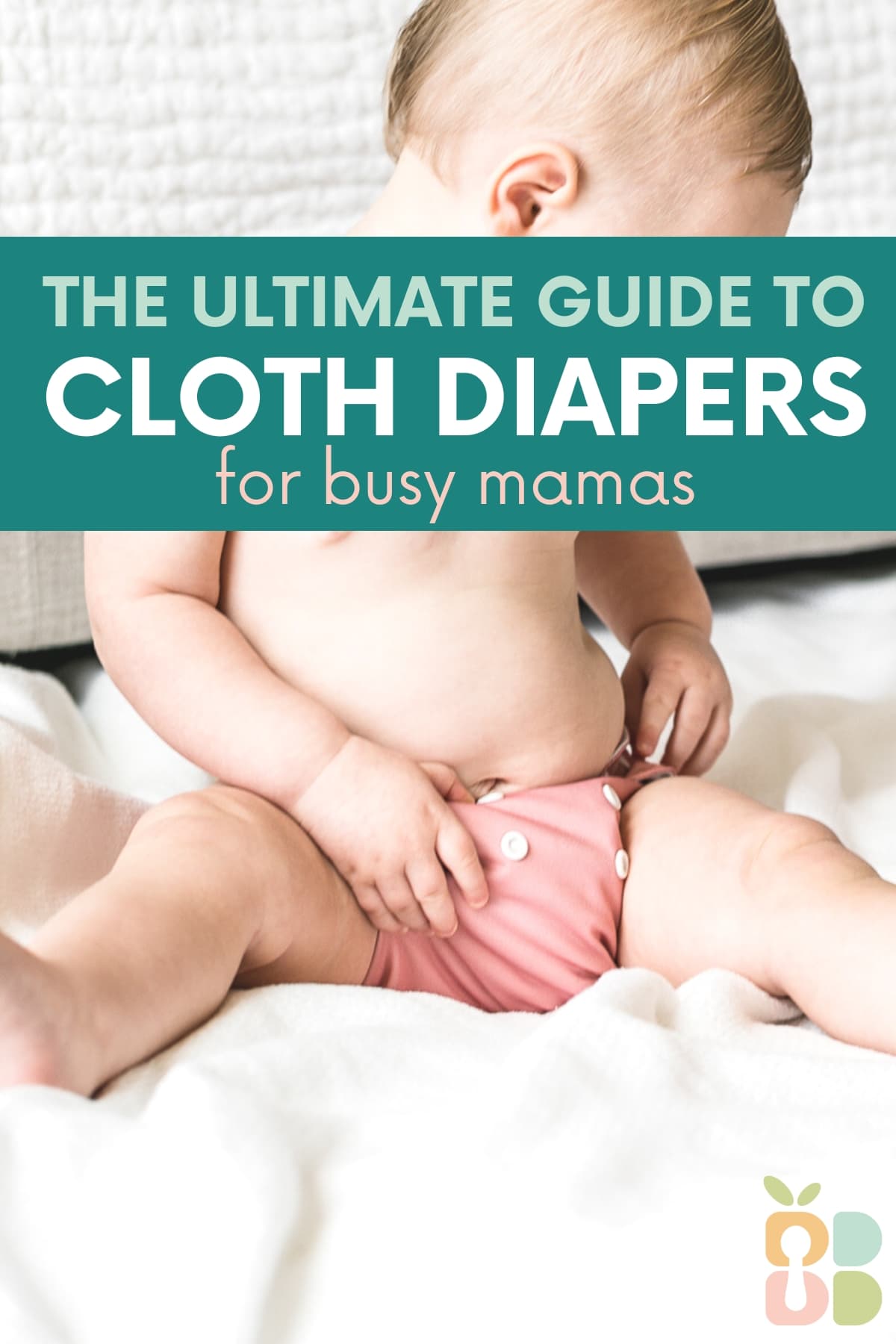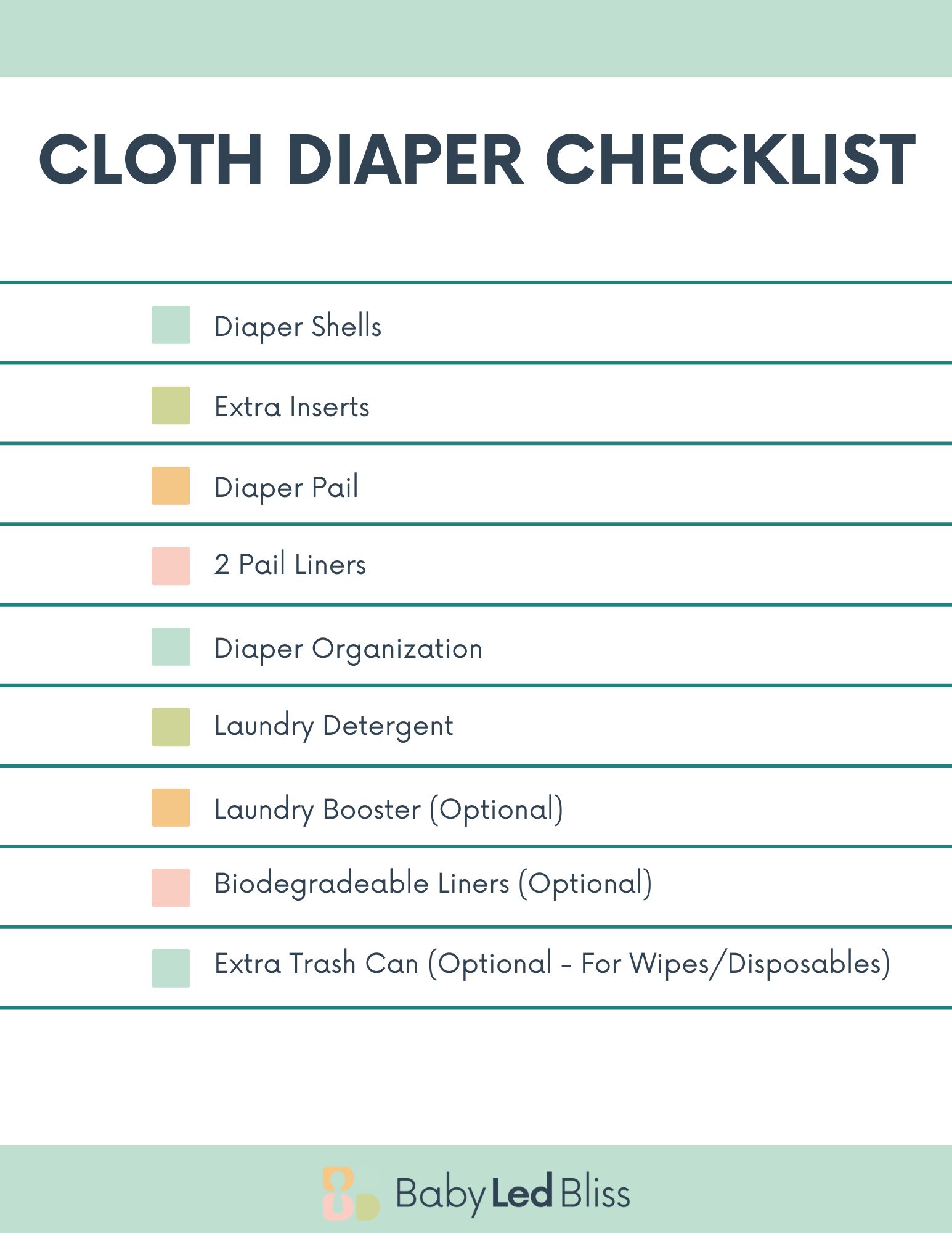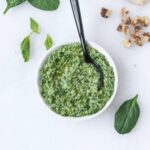Interested in using cloth diapers, but feeling overwhelmed or unsure of where to begin? I'll walk you through everything you need to know in this stress-free guide to cloth diapering for busy moms.

If you told me two years ago that I'd be writing a post on cloth diapers, I would have laughed in your face. Cloth diapering was something I never had any interest in. In fact, I was in the "no way will I ever use cloth diapers" camp. But a second baby and a pandemic later, I'm singing a much different tune.
My dear fried Amy actually put the thought of using cloth diapers in my head. She had three girls (now 5 kids!) at the time who were about the same age as my own little ones, and she used cloth diapers with all of them. She was convincing enough to make me think about using cloth diapers when I was pregnant with baby number 2, but I still wasn't completely sure I could handle it. Months later after I had given birth to my second, the pandemic hit, and in a moment of buying panic during the early days (circa the toilet paper shortage), I bought a full setup for cloth diapers. You know, just in case. They sat unused for weeks.
Then I figured that since I already had the cloth diapers, I might as well use them. And I actually loved them! Using cloth diapers was much easier than I thought it would be. BUT getting started was completely overwhelming. That's why I'm sharing this post with you.
If you're new to the cloth diapering world, it helps to have a friend or family member (AKA an Amy) who uses cloth diapers to get you up to speed and give you some confidence. It can be really intimidating to just search "cloth diapers" because there are SO many options and tons of information. In the beginning, Amy sent me a comprehensive email that someone had shared with her, and it was so helpful that I've decided to pass along all the information to you in a concise, easy to understand format so that you feel confident with cloth diapers, too! In other words, I'm here to be your Amy.

Why Use Cloth Diapers?
There are so many reasons parents choose to use cloth diapers. Just a few benefits of cloth diapers:
- They're healthier for the environment (no diapers in the landfill!)
- They save you tons of money over the long term - especially if you're going to have more than one child.
- They help with potty training, because your child is already used to feeling when he or she is wet, which doesn't happen with disposable diapers.
- They're healthier and gentler on babies' skin. No chemicals or fragrances, which I feel so much better about!
What Kind of Cloth Diapers To Buy
There are tons of different cloth diapering options. They each have different levels of convenience and cost. And if you're unfamiliar, it's overwhelming to sort through. What I used, and what I'll be talking about, are pocket diapers, because that's what I have experience with. But the same information can be applied to sleeve and all-in-two diapers, which are all the same basic idea with slight design differences.
I highly recommend pocket diapers because I find that they are easiest to use and wash. However, different types work for different people, so go with what works best for you. I bought mine from Nora's Nursery because I love their large range of non-obnoxious colors. Grovia is another popular option that I know people rave about!

How To Assemble and Put On Cloth Diapers
First let me break down the terminology. With a pocket diaper you have:
- The Shell - The outer cover that is usually colorful and has either snaps or velcro to secure the diaper.
- The Inserts - The absorbent pieces of cloth that go inside the diaper to absorb the wetness. They are usually made of bamboo, fleece, or microfiber. I find the fleece most absorbent.
- The Pocket - The pocket is built into the inside of pocket diapers and sleeve diapers, and it's where the insert goes.
To assemble pocket diapers, you stick the insert into the pocket (or snap it in if you have all-in-two or hybrid), then put the diaper on your baby just like you would a disposable diaper, using the snaps or velcro to close it. HOWEVER, what I prefer to do is to stick the insert ON TOP of the pocket instead of inside it. This makes it super easy to just change out the insert and replace it with a fresh one when it is wet or dirty instead of having to change the entire diaper. This way, you go through fewer shells (and won't have to buy as many!) which equates to less laundry. Washing the shells less frequently also reduces the wear on them so that they last longer.
How To Change Cloth Diapers
Changing cloth diapers - the part most people dread! Honestly, it really isn't that bad. For diaper changes, you'll need a diaper pail. Diaper pail = receptacle for dirty/wet diapers. I just use a small trash can with a lid, lined with a wet bag.
When your baby's diaper is wet, simply take it off and place it in the diaper pail (your prepared trash can) and put a clean one on your baby. Or if you placed the insert on top instead of inside the pocket, you can place just the insert in the diaper pail and use a clean one with the same shell.
You'll handle dirty diapers differently depending on how your baby is fed at the time. If your baby is:
- Exclusively breastfed or combo breastmilk/formula fed - You can throw soiled diapers directly into the pail and move on. Breastmilk poop (or comb breastmilk/formula) is water soluble so it can go right in the wash.
- Exclusively formula fed OR starting solids - You'll have to do a little more work. Most poops are easy to just shake off into the toilet, then you can place the insert into the pail. If it's a little more stubborn, you may have to try a little harder to get the poop into the toilet. Some moms invest in a diaper sprayer or use a dedicated diaper spatula. Others are fine just using toilet paper. I find it easiest to use the sprayer nozzle on the sink to rinse particularly messy diapers, then sanitize the sink afterward. You may also choose to use disposable liners, which will catch solids and make diaper changes easier. I used these for a little bit while making the transition to solid foods and they really made things easier.
No matter what method you choose, don't worry about getting the inserts completely clean, they're all going in the wash anyway!

How To Wash Cloth Diapers
Washing cloth diapers is typically pretty easy. Simply throw all the dirty diapers, inserts, and wet bag/pail liner into the washing machine and do a cold rinse. Then wash on the hottest, most powerful setting on your washing machine with a full load of detergent. You can also use an oxygen booster or other booster (more on that below). Then, throw everything in the dryer. Some people line dry their shells, but I don't. If you have staining, drying in direct sunlight can help lighten the stain.
There are a few things you'll need to know about laundering cloth diapers:
- You'll need to wash diapers every 2-3 days. That's why I have a very small dirty diaper pail. If dirty diapers sit too long, they can build up ammonia, which is irritating to baby's skin (and stinky!).
- Plant based and all-natural detergents are not the best for washing cloth diapers. Especially if you have hard water. Unfortunately, you need to surfactants in normal detergent to soften water to prevent buildup on diapers. I've had good luck with Tide Free and Clear powder detergent.
- If you have very hard water (we do!) you may need a booster. I used either a scoop of Branch Basics Oxy Boost, a capful of Branch Basics Concentrate, Charlie's Laundry Booster, or Funk Rock Ammonia Bouncer, which help to get diapers more clean in hard water.
- Stripping. Even after following these guidelines, you may still have to strip your diapers if they collect too much buildup from washing in hard water (or if they sit dirty for too long!). I've had to do it a few times. If you need help stripping, there are tons of resources out there. Or send me an email and I'll walk you through it!
Things That Will Make Cloth Diapering Easier For You!
I'm all about the least amount of stress when it comes to all things parenting. Here are my top tips for making your life easier when it comes to cloth diapers:
- As mentioned, disposable or flushable liners are great for transitioning from breastmilk to solids. They're also great for when you have to use diaper cream, as most diaper creams will cause buildup on cloth diapers.
- Get two wet bags or pail liners. You'll need one for the diaper pail while the other is in the wash. You'll probably also want another trash can for disposable items such as baby wipes.
- Dark colored inserts are your friend. I love these charcoal colored fleece inserts because you can't see any staining!
- Get the diapers with the snaps. They last longer than velcro, and your baby can't get them apart. You're welcome.
- You may still want to use disposables with small newborns (the cloth may not fit yet), while baby is sleeping at night if they wet a lot, and when traveling or at daycare. I use Dyper bamboo disposable diapers for nighttime to prevent leaks, and when traveling. I love that they're more eco-friendly, and have no yucky chemicals!
- Remember that cloth doesn't have to be all or nothing, so give yourself a little grace!

Complete Supply List for Cloth Diapering
- Diaper shells
- Diaper inserts
- Biodegradeable liners (optional)
- Diaper pail for dirty diapers
- 2 Pail liners for diaper pail
- Second trash can for disposables (baby wipes)
- A way to organize diapers
- Laundry detergent
- Oxy Boost or diaper laundry booster
- Water softener laundry treatment (If you have hard water)
There you have it! Your complete guide to cloth diapering with less stress! If you found this post helpful, please share on social media or tell your mama friends! If you have a question or you're already a cloth diapering pro with tips and tricks, please drop them in the comments below!

















Leave a Reply